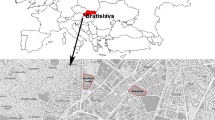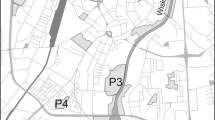Abstract
This research was designed to compare allergenic flora of various cities of central Italy. Because the data on this problem are rather scant, we wanted to highlight the relationships among the ecological conditions of the urban habitats, and the plants whose pollens cause allergic manifestations in the human population. Our results pointed out that the structural design of the urban land use types play an important role in the distribution of allergophytes. The compact structure of the historic city center does not impede the establishment of allergophytes. Actually, it promotes some species that come from the dry pastures and rocky walls of the surrounding ecosystems. Allergenicity was revealed throughout the urban area, with a prevalence of species with monoporate pollens characteristic of the Poaceae. Highly allergenic plants are present in the central zone (within the city walls) and in some peripheral land use models (urban road verges). The particular abundance of Urticaceae with small triporate pollen grains and of various cultivated species, introduced by man for aesthetic reasons, contributes to the increase of allergophytism. The study points out the role of the interactions between the allergenic flora, human impact through the land use patterns, urban fauna, and the meso- and microclimatic conditions of the cities studied.




Similar content being viewed by others
References
Accorsi, C. A., & Bandini Mazzanti, M. (1980). Studi sui pollini allergogeni. Parietaria officinalis L. e Parietaria judaica L.: Posizione sistematica, morfologia e biometria del polline. Webbia, 34(2), 634–661.
Alberti, M., Marzluff, J. M., Shulenberger E., Bradley, G., Ryan, C., & Zumbrunnen, C. (2003). Integrating humans into ecology: Opportunities and challenges for studying urban ecosystems. BioScience, 53, 1169–1179.
Allergome (2003–2006). A database of allergenic molecules. Latina: Institutions for Allergome Project, Italy. http://www.allergome.org.
Antrop, M. (2004). Landscpe changes and the urbanisation process in Europe. Landscape and Urban Planning, 67, 9–26.
Bullock, J. M., Kenward, K. E., & Hails, R. S. (2002). Dispersal ecology. Oxford: Blackwell.
Cariñanos, P., Alcazar, P., Galàn C., & Dominguez, E. (2002). Privet pollen (Ligustrum L.) as potential cause of pollinosis in the city of Cordoba, south-west Spain. Allergy, 57, 92–97.
Diekmann, M. (2003). Species indicator values as an important tool in applied plant ecology—a review. Basic and Applied Ecology, 4(6): 493–506.
Dow, K. (2000). Social dimensions of gradients in urban ecosystems. Urban Ecosystems, 4, 255–275.
Ellenberg, H., Weber, H. E., Düll, R., Wirth, V., Werner, W., & Paulissen, D. (1991). Zeigerwerte von Pflanzen in Mitteleuropa (2nd ed.). Scripta Geobotanica, 18, 1–258.
Eriksson, N. E. (1993). Food introduced urticaria. Allergy Supplement, 48, 48–49.
Falinski, J. B. (1998). Invasive allien species, vegetation dynamics and neophytism. Phytocoenosis, 10 (N.S.), Supplementum Cartographiae Geobotanicae, 9, 163–187.
Farina, A. (1997). Landscape structure and breeding bird distribution in a sub-mediterranean agroecosystem. Landscape Ecology, 12, 365–378.
Feldman, R. E., & Krannitz, P. G. (2004). Bird composition of oak ecosystem fragments in an urbanized setting: The influence of adjacent coniferous forest fragments. Ecoscience, 11(3), 338–346.
Forman, R. T. T. (1995). Land mosaics: The ecology of landscape and regions. Cambridge: Cambridge Univ. Press.
Forman R. T. T., Sperling D., Bissonette J. A., Clevenger A. P., Cutshall C. D., Dale V. H., Fahrig L., France R., Goldman C. R., Heanue K., Jones J. A., Swanson F. J., Turrentine T., & Winter T. C. (Eds.) (2003). Road ecology. Science and solutions. Washington DC: Island.
Garzia Mozo, H., Comtois, P., & Kuehne, E. (2004). Aerobiological clines: The role of topography as a barrier for establishing dispersal corridors. Aerobiologia, 20, 161–172.
Godron, M., & Forman, R. T. T. (1983). Landscape modification and changing ecological characteristics. In H. A. Mooney & M. Godron (Eds.), Disturbance and ecosystems (pp. 12–28). New York: Springer.
Gottman, J., & Harper, R. A. (1967). Metropolis on the move: Geographers look at urban sprawl. New York: Wiley.
Grant Smith, E. (1990). Sampling and identifying allergenic pollens and molds. San Antonio, Texas: Blewstone Press.
Grime, J. P. (2001). Plant strategies, vegetation processes and ecosystem properties (2nd ed.). Chichester: Wiley
Grimm, N. B., Grove, J. M., Redman C. L., & Pickett, S. T. A. (2000). Integrated approaches to long-term studies of urban ecological systems. BioScience, 50(7), 571–584.
Haberl, H. (1997). Human appropriation of net primary production as an environmental indicator: implications for sustainable development. Ambio, 26(3), 143–146.
Hess, G. R., & Fischer, R. A. (2001). Communicating clearly about conservation corridors. Landscape and Urban Planning, 55, 195–208.
Hruska, K. (2000). Phytoecological research in the urban environment in Italy. Acta Botánica Croatica, 59(1), 135–143.
Hruska, K. (2003). Assesment of urban allergophytes using an allergen index. Aerobiologia, 19(2), 107–111.
Hruska, K. (2006). Notes on the evolution and organization of the urban ecosystem. Urban Ecosystems, 9(4), 291–298.
Hruska, K., & Piarulli, C. (1995). Ricerche sui rapporti tra le allergofite urbane e le allergopatie nella popolazione umana. Informatore Botanico Italiano, 27(2–3), 245–252.
Kornas, J. (1982). Man’s impact upon the flora. Processes and effects. Memorabilia Zoologica, 37, 11–30.
Kowarik, I. (1990). Some responses of flora and vegetation to urbanisation in central Europe. In H. Sukopp & S. Hejny (Eds.), Urban ecology: Plants and plant communities in urban environment (pp. 46–74). Den Haag: SPB Academic.
Larson, D. W., Matthes, U., Kelly, P. E., Lundholm, J. T., & Gerrath, J. A. (2004). The urban cliff revolution: New findings on the origins and evolution of human habitats. Whiteside, Canada: Fitzhenry & Markham.
Magurran, A. E. (2004). Measuring biological diversity. Oxford: Blackwell.
McDonnell, M. J., & Pickett, S. T. A. (1997). Humans as components of ecosystems. New York: Springer.
McDonnell, M. J., Pickett, S. T. A., Groffman, P., Bohlen, P., Pouyat, R. V., Zipperer, C., Parmelee R. W., Carreiro, M. M., & Medley, K. (1997). Ecosystem processes along an urban to rural gradient. Urban Ecosystems, 1, 21–36.
McKinney, M. (2006). Urbanization as a major cause of biotic homogenization. Biological Conservation, 127(3), 247–260.
Oberdorfer, E. (1975). Die Mauerfugen Vegetation Siziliens. Phytocoenologia, 2(1–2): 146–153.
Oberdorfer, E. (1977–1992). Süddeutsche Pflanzengesellschaften I, II, III, IV. Jena: Fischer Verlag.
Palmieri, S., & Siani, A. M. (2000). Clima urbano. In K. Hruska (Ed.), Ecologia urbana (pp. 35–62). Napoli: CUEN.
Pickett, S. T. A., Cadenasso, M. L., Grove, J. M., Nilson, C. H., Poyat, R. V., Zipperer, W. C., & Costanza, R. (2001). Urban ecological systems: Linking terrestrial ecological, physical and socioeconomic components of metropolitan areas. Annual Review of Ecology and Systematics, 32, 127–157.
Platt-Mills, T. A. (1994). How environment affects patients with allergic disease: Indoor allergies and asthma. Annals of Allergy, 72(4), 381–384.
Pysek, P., & Hulme, P. E. (2005). Spatio-temporal dynamics of plant invasions: Linking pattern to process. Ecoscience, 12(3), 302–315.
Pysek, P., Richardson D. M., Rejmanek M., Webster G. L., Williamson M., & Kirschner, J. (2004). Alien plants in checklists and floras: Towards better communication between taxonomists and ecologists. Taxon, 53(1), 131–143.
Quirce, S., & Sastre, J. (1998). Occupational asthma. Allergy, 53, 633–641.
Ryan, P. D., Harper, D. A. T., & Whalley, J. S. (1994). PALSTAT: User’s manual and case histories. Dordrecht: Kluwer Academic.
Staffolani, L. (2007). Studio ecologico del potenziale fitoallergenico nell’ecosistema urbano dell’Italia centrale. Italy: Dissertation, University of Camerino.
Sukopp, H. (1998a). On the study of anthropogenic plant migrations in central Europe. In K. Starfinger, I. Edwards, I. Kowarik, & M. Williamson (Eds.), Ecological mechanisms and human responses (pp. 43–56). Leiden: Backhuys Publishers.
Sukopp, H. (1998b). Urban ecology—scientific and practical aspects. In J. Breuste, H. Feldmann, & O. Uhlmann (Eds.), Urban ecology (pp. 3–16). Berlin: Springer.
Sukopp, H., Numata, M., & Huber, A. (1995). Urban ecology as the basis for urban planning. The Hague: SPB Academic.
Turner B. L., Clark W. C., Kates R. W., Richards J. F., Mathews J. T., & Meyer W. B. (Eds.) (1991). The earth as transformed by human action: Global and regional changes in the biosphere over the past 300 years. Cambridge: Cambridge University Press.
Van der Pijl, L. (1982). Principles of dispersal in higher plants. Berlin: Springer.
Wittig, R. (2004). The origin and development of the urban flora of Central Europe. Urban Ecosystems, 7, 323–339.
World Resources Institute (2001). World resources 2000–2001. Washington DC: WRI.
Zerbe S., Maurer U., Schmitz S., & Sukopp, H. (2002). Biodiversity in Berlin and its potential nature conservation. Landscape and Urban Planning, 62(3), 139–148.
Author information
Authors and Affiliations
Corresponding author
Appendix
Appendix
The most important allergophytes found in the land use patterns of the urban ecosystems of central Italy (species present with less than 10% abundance are not included in the list)
Species | Family | Abbreviation |
|---|---|---|
Acer campestre L. | Aceraceae | Ac.ca |
Ailanthus altissima (Miller) Swingle | Simaroubaceae | Ai.al |
Amaranthus deflexus L. | Amaranthaceae | Am.de |
Arrhenaterum elatius (L.) Pers. | Poaceae | Ar.el |
Artemisia alba Turra | Asteraceae | Ar.al |
Artemisia vulgaris L. | Asteraceae | Ar.vu |
Avena sativa L. | Poaceae | Av.sa |
Bromus erectus Hudson | Poaceae | Br.er |
Bromus hordeaceus L. | Poaceae | Br.ho |
Bromus madritensis L. | Poaceae | Br.ma |
Cichorium intybus L. | Asteraceae | Ci.in |
Chenopodium album L. | Chenopodiaceae | Ch.al |
Corylus avellana L. | Corylaceae | Co.av |
Cupressus sempervirens L. (cult.) | Cupressaceae | Cu.se |
Cynodon dactylon (L.) Pers. | Poaceae | Cy.da |
Daucus carota L. | Apiaceae | Da.ca |
Dactylis glomerata L. | Poaceae | Da.gl |
Diplotaxis erucoides (L.) DC. | Brassicaceae | Di.er |
Echinochloa crus-galli L. | Poaceae | Ec.cr |
Elymus repens (L.) Gould. | Poaceae | El.re |
Ficus carica L. | Moraceae | Fi.ca |
Foeniculum vulgare Miller | Apiaceae | Fo.vu |
Fraxinus excelsior L. | Oleaceae | Fr.ex |
Hordeum murinum L. | Poaceae | Ho.mu |
Juglans regia L. (cult.) | Juglandaceae | Ju.re |
Juniperus communis L. | Cupressaceae | Ju.co |
Ligustrum vulgare L. | Oleaceae | Li.vu |
Lolium multiflorum Lam. | Poaceae | Lo.mu |
Lolium perenne L. | Poaceae | Lo.pe |
Matricaria chamomilla L. | Asteraceae | Ma.ch |
Medicago sativa L. | Fabaceae | Me.sa |
Mercurialis annua L. | Euphorbiaceae | Me.an |
Ostrya carpinifolia Scop. | Corylaceae | Os.ca |
Olea europea L. (cult.) | Oleaceae | Ol.eu |
Parietaria diffusa Mert. et Koch | Urticaceae | Pa.di |
Parietaria officinalis L. | Urticaceae | Pa.of |
Papaver rhoeas L. | Papaveraceae | Pa.rh |
Plantago lanceolata L. | Plantaginaceae | Pl.la |
Plantago major L. | Plantaginaceae | Pl.ma |
Platanus orientalis L. (cult.) | Platanaceae | Pl.or |
Picea abies (L.) Kartsen (cult.) | Pinaceae | Pi.ab |
Pinus pinea L. (cult.) | Pinaceae | Pi.pi |
Poa annua L. | Poaceae | Po.an |
Poa nemoralis L. | Poaceae | Po.ne |
Quercus ilex L. (cult.) | Fagaceae | Qu.il |
Robinia pseudoacacia L. | Fabaceae | Ro.ps |
Rosa canina L. | Rosaceae | Ro.ca |
Rubus idaeus L. | Rosaceae | Ru.id |
Sambucus nigra L. | Caprifoliaceae | Sa.ni |
Saponaria officinalis L. | Caryophyllaceae | Sa.of |
Sorghum halepense (L.) Pers. | Poaceae | So.ha |
Taraxacum officinale Weber | Asteraceae | Ta.of |
Trifolium pratense L. | Fabaceae | Tr.pr |
Triticum aestivum L. | Poaceae | Tr.ae |
Urtica dioica L. | Urticaceae | Ur.di |
Vicia sativa L. | Fabaceae | Vi.sa |
Rights and permissions
About this article
Cite this article
Staffolani, L., Hruska, K. Urban allergophytes of central Italy. Aerobiologia 24, 77–87 (2008). https://doi.org/10.1007/s10453-008-9084-4
Received:
Accepted:
Published:
Issue Date:
DOI: https://doi.org/10.1007/s10453-008-9084-4




